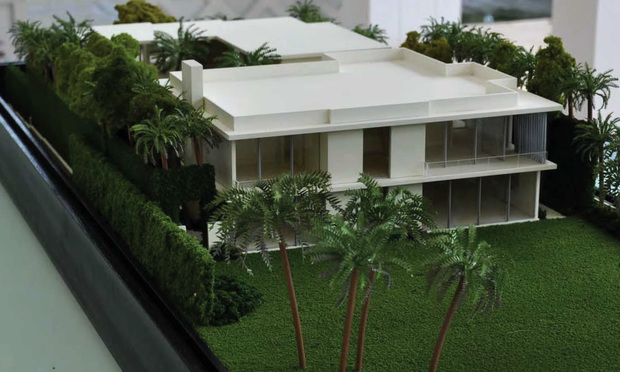Does the First Amendment Protect Home Architecture? 11th Circuit to Decide
Can a house make an artistic statement? This case before the U.S. Court of Appeal for the Eleventh Circuit seeks to find out.
April 03, 2020 at 05:56 PM
4 minute read
 Model of Burns' proposed new home as demonstrative exhibit rotated view. Courtesy photo
Model of Burns' proposed new home as demonstrative exhibit rotated view. Courtesy photo
A novel South Florida constitutional-rights case had its moment before the U.S. Court of Appeals for the Eleventh Circuit on Friday, when lawyers debated whether the First Amendment should protect the architectural design plans for a plaintiff's house.
Plaintiff Donald Burns sued the town of Palm Beach in 2017, after its architectural commission voted down plans to turn his traditional-style, beachfront home into a larger, more modern structure with a minimalist design.
The board struck down that idea, finding the house would have been "excessively dissimilar" to and "not in harmony" with neighboring properties, but Burns claimed that wrongly restricted his rights to self expression.
The Eleventh Circuit must decide whether U.S. District Judge Beth Bloom of the Southern District of Florida was right to side with Palm Beach.
Plaintiffs counsel Laurie Webb Daniel of Holland & Knight's Atlanta office insisted that her client's home was "an expression of his persona, his philosophy, to show that he was not tied to the past."
She alleged the board's architectural code was vague and uneven in how it was applied, and argued the lower court used the wrong test to find Palm Beach didn't infringe on Burns's First Amendment rights. Daniel is handling the case with Jennifer Mansfield and Matthew Friedlander of Holland & Knight's Jacksonville and Atlanta offices.
Defense attorney Joanne O'Connor of Jones Foster in West Palm Beach urged the appellate panel to consider historical and societal context.
"Never has the exterior facade of a home been understood to be a medium through which its residents communicate with the outside world," O'Connor said.
O'Connor is handling the case with John Randolph.
Burns is the first plaintiff to attempt to apply the First Amendment to a zoning decision—which Eleventh Circuit Chief Judge Ed Carnes remarked wasn't necessarily because it didn't apply, but because nobody's "had the audacity" to take this position before.
The Eleventh Circuit looked to a case in which it ruled that a Fort Lauderdale community event for homeless people was protected by the First Amendment, despite an ordinance that banned food distribution in public parks without a permit.
Judge Robert Luck highlighted some crucial difference between the cases.
"Is your client setting up tables and distributing literature to come look at his house, so that others can see the message?" Luck said. "Did he invite groups to come share and for bus tours to come, 'Please see my house and the message that I want to convey?' Is this in a city park?"
The fate of the lawsuit could hinge on whether Burns' house would be visible to the public. While the plaintiff noted that it's next to a public beach, the defense argued it was set back from the street and that trees and shrubbery would block it from view.
The property's unusual modern design also resulted in some confusion over which part was the front or back, but O'Connor claimed the front faced the street and wouldn't be visible.
"If this house is designed to send a message, it's clearly pointing the wrong way," O'Connor said. "Any message is being sent out into a void."
But Judge Stanley Marcus challenged that assumption, noting that, "I thought the very reason neighbors objected was precisely because it was visible and it was an eyesore, not that it was hidden, but that it was obvious, it was massive and excessively dissimilar."
Daniel argued observers don't necessarily have to understand what message her client hopes to convey.
"If you look at a painting of Jackson Pollock or a 'Jabberwocky' verse of Lewis Carroll, people are going to have different understandings of the message," Daniel said. "That's common with art and artistic expression."
The appellate panel noted that if it were to rule for Burns, that could throw all zoning decisions into question, pointing to cities like Paris, France, and Coral Gables, Florida, to suggest some communities are within their right to maintain a certain architectural look.
The court is yet to rule.
More appeals:
Survivors of Pulse Nightclub Shooting Tested Florida's Negligence Law — and Lost
Clock Ticking for Florida Family Alleging Radiation Exposure Caused Teen's Cancer
This content has been archived. It is available through our partners, LexisNexis® and Bloomberg Law.
To view this content, please continue to their sites.
Not a Lexis Subscriber?
Subscribe Now
Not a Bloomberg Law Subscriber?
Subscribe Now
NOT FOR REPRINT
© 2025 ALM Global, LLC, All Rights Reserved. Request academic re-use from www.copyright.com. All other uses, submit a request to [email protected]. For more information visit Asset & Logo Licensing.
You Might Like
View All
US Judge Dismisses Lawsuit Brought Under NYC Gender Violence Law, Ruling Claims Barred Under State Measure

No Two Wildfires Alike: Lawyers Take Different Legal Strategies in California
5 minute read
Second DCA Greenlights USF Class Certification on COVID-19 College Tuition Refunds
3 minute read
Florida Law Firm Sued for $35 Million Over Alleged Role in Acquisition Deal Collapse
3 minute readLaw Firms Mentioned
Trending Stories
- 1Starbucks Sues Ex-Executive to Recover $1M Signing Bonus
- 2Navigating AI Risks: Best Practices for Compliance and Security
- 320 New Judges? Connecticut Could Get Wave of Jurists
- 4Orrick Loses 10-Lawyer Team to Herbert Smith in Germany
- 5‘The US Market Is Critical’: KPMG’s Former Head of Global Legal Services On the Legal Arm of the Big Four Firm Entering the US
Who Got The Work
J. Brugh Lower of Gibbons has entered an appearance for industrial equipment supplier Devco Corporation in a pending trademark infringement lawsuit. The suit, accusing the defendant of selling knock-off Graco products, was filed Dec. 18 in New Jersey District Court by Rivkin Radler on behalf of Graco Inc. and Graco Minnesota. The case, assigned to U.S. District Judge Zahid N. Quraishi, is 3:24-cv-11294, Graco Inc. et al v. Devco Corporation.
Who Got The Work
Rebecca Maller-Stein and Kent A. Yalowitz of Arnold & Porter Kaye Scholer have entered their appearances for Hanaco Venture Capital and its executives, Lior Prosor and David Frankel, in a pending securities lawsuit. The action, filed on Dec. 24 in New York Southern District Court by Zell, Aron & Co. on behalf of Goldeneye Advisors, accuses the defendants of negligently and fraudulently managing the plaintiff's $1 million investment. The case, assigned to U.S. District Judge Vernon S. Broderick, is 1:24-cv-09918, Goldeneye Advisors, LLC v. Hanaco Venture Capital, Ltd. et al.
Who Got The Work
Attorneys from A&O Shearman has stepped in as defense counsel for Toronto-Dominion Bank and other defendants in a pending securities class action. The suit, filed Dec. 11 in New York Southern District Court by Bleichmar Fonti & Auld, accuses the defendants of concealing the bank's 'pervasive' deficiencies in regards to its compliance with the Bank Secrecy Act and the quality of its anti-money laundering controls. The case, assigned to U.S. District Judge Arun Subramanian, is 1:24-cv-09445, Gonzalez v. The Toronto-Dominion Bank et al.
Who Got The Work
Crown Castle International, a Pennsylvania company providing shared communications infrastructure, has turned to Luke D. Wolf of Gordon Rees Scully Mansukhani to fend off a pending breach-of-contract lawsuit. The court action, filed Nov. 25 in Michigan Eastern District Court by Hooper Hathaway PC on behalf of The Town Residences LLC, accuses Crown Castle of failing to transfer approximately $30,000 in utility payments from T-Mobile in breach of a roof-top lease and assignment agreement. The case, assigned to U.S. District Judge Susan K. Declercq, is 2:24-cv-13131, The Town Residences LLC v. T-Mobile US, Inc. et al.
Who Got The Work
Wilfred P. Coronato and Daniel M. Schwartz of McCarter & English have stepped in as defense counsel to Electrolux Home Products Inc. in a pending product liability lawsuit. The court action, filed Nov. 26 in New York Eastern District Court by Poulos Lopiccolo PC and Nagel Rice LLP on behalf of David Stern, alleges that the defendant's refrigerators’ drawers and shelving repeatedly break and fall apart within months after purchase. The case, assigned to U.S. District Judge Joan M. Azrack, is 2:24-cv-08204, Stern v. Electrolux Home Products, Inc.
Featured Firms
Law Offices of Gary Martin Hays & Associates, P.C.
(470) 294-1674
Law Offices of Mark E. Salomone
(857) 444-6468
Smith & Hassler
(713) 739-1250






